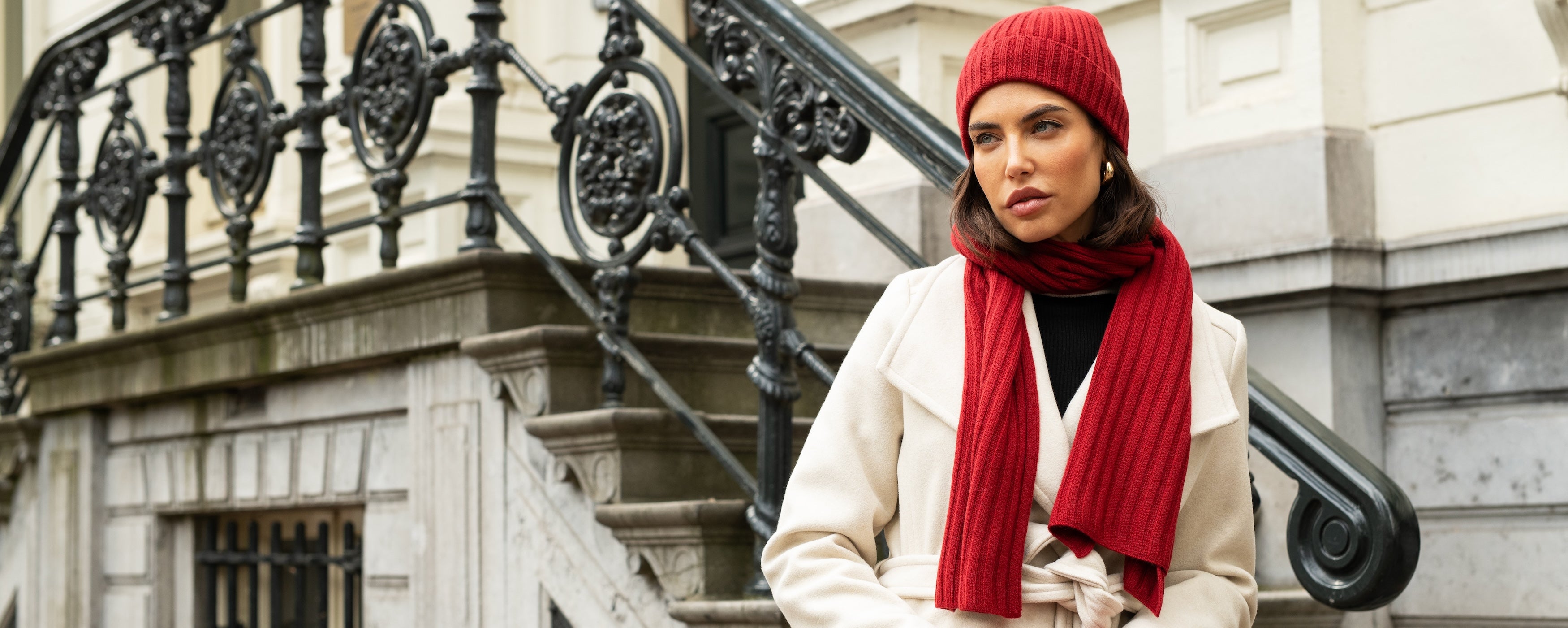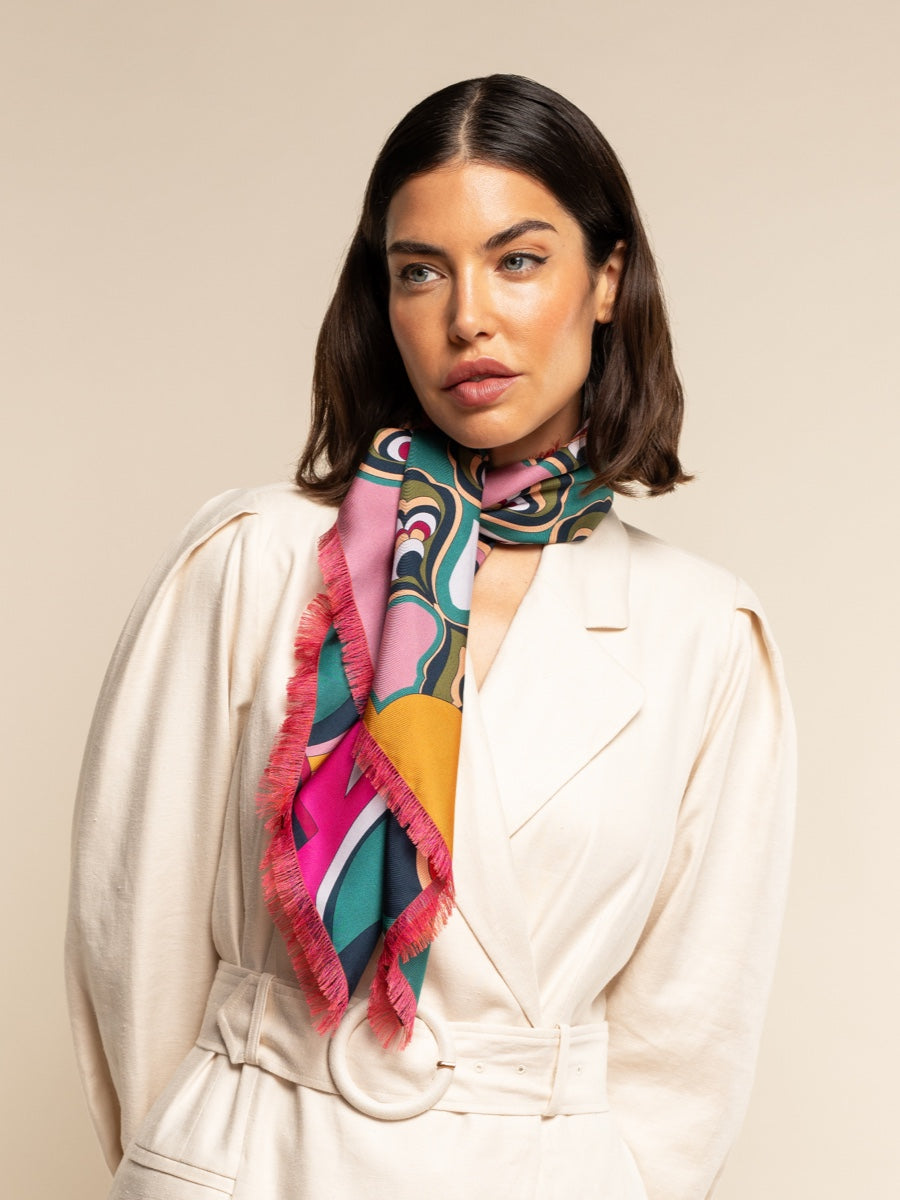Cashmere, a material synonymous with luxury and comfort, has long been coveted for its softness, warmth, and durability. Sourced from the undercoat of the Cashmere goat, this exquisite fiber is lighter and up to three times more insulating than sheep wool, making it a premium choice for high-quality accessories.
The Rich Tapestry of Cashmere's History
The journey of cashmere is as rich and diverse as the fabric itself. Originating in the Himalayan regions of Kashmir, where it was first woven into shawls for the Mughal royalty, cashmere has traversed continents and centuries to become a staple in the wardrobes of the fashion-conscious. Its transformation from an exclusive luxury to a modern-day must-have illustrates a fascinating evolution in textile history, reflecting changes in technology, trade, and tastes.
Diving Deep into Cashmere Scarves
Cashmere scarves are not just accessories; they are statements of elegance that elevate any outfit. Available in an array of styles, from the understated solid colors and classic checks to the more elaborate prints and patterns, they cater to a wide range of preferences. The versatility of cashmere scarves allows them to be styled in numerous ways, be it draped elegantly over the shoulders or tied snugly for warmth. Proper care is crucial for maintaining the beauty and softness of cashmere. Gentle hand washing in cold water with a mild detergent and laying flat to dry ensures that these luxurious accessories remain in pristine condition for years to come.

The Cozy Appeal of Cashmere Beanies
Cashmere beanies represent the perfect amalgamation of style and functionality. They not only keep you warm during the cold months but also add a touch of sophistication to your winter attire. The softness of cashmere against the skin is unparalleled, offering comfort without the itchiness associated with other woolen hats. To care for your cashmere beanie, similar gentle washing and drying practices as for scarves will keep it looking and feeling soft and new.
Ethical and Sustainable Cashmere: A Modern Imperative
The growing demand for cashmere has spotlighted the importance of ethical sourcing and sustainability in its production. With overgrazing leading to environmental degradation in regions where cashmere goats are farmed, it's imperative for consumers to support brands that invest in sustainable practices, ensuring the welfare of animals and the land they inhabit.
Identifying Genuine Cashmere
In a market flooded with imitations, knowing how to identify genuine cashmere is key. Authentic cashmere is distinguished by its softness, warmth, and a subtle sheen. It should feel luxurious to the touch and offer significant warmth without bulk. Be cautious of low-priced items and always check for certification and quality marks when purchasing cashmere products.
Price vs. Value: The Cashmere Equation
The investment in cashmere accessories goes beyond their initial price tag. The true value of cashmere lies in its longevity, timeless appeal, and the way it can elevate the simplest of outfits with a touch of luxury. With proper care, cashmere pieces can last for decades, making them a sustainable choice for the environmentally conscious consumer.
Trends and Innovation in Cashmere Designs
The world of cashmere accessories is constantly evolving, with designers blending traditional craftsmanship with contemporary trends. From the revival of vintage patterns to the introduction of bold, statement-making colors, the innovation in cashmere designs keeps this age-old fabric in the limelight of modern fashion.
Harmonizing Cashmere with Your Wardrobe
Integrating cashmere into your wardrobe is both an art and a science. The key is to match the luxurious texture of cashmere with other high-quality fabrics. Silk, fine cotton, and soft wool complement cashmere's delicacy, creating harmonious outfits that speak volumes of your style and sophistication.
The Intangible Benefits of Wearing Cashmere
Beyond the tangible qualities of warmth and softness, cashmere imparts a sense of well-being and luxury. The psychological comfort derived from wrapping oneself in the soft embrace of cashmere can elevate mood and boost confidence, making it more than just a clothing item but a wellness accessory.
Navigating the Global Cashmere Market
The cashmere market is a global tapestry with major producers like China and Mongolia leading the way. Understanding the dynamics of this market, from the challenges of sustainable production to the trends shaping consumer demand, is essential for both enthusiasts and investors in the luxury fashion industry.
Bespoke Cashmere: The Ultimate Luxury
For those seeking exclusivity, custom-made cashmere pieces offer unparalleled luxury. Whether it's a scarf monogrammed with your initials or a beanie knitted to your exact specifications, bespoke cashmere services provide a personal touch that elevates the luxury experience.

Conclusion: The Timeless Charm of Cashmere
In the world of luxury fabrics, cashmere holds a special place for its blend of elegance, comfort, and warmth. As we navigate the complexities of modern fashion and sustainability, the timeless appeal of cashmere scarves and beanies remains undiminished, symbolizing a heritage of craftsmanship and the enduring allure of luxury.
Frequently asked questions:
-
How can I verify the authenticity of my cashmere accessory?
To ensure the authenticity of a cashmere product, look for specific markers such as the softness of the material, the fineness of the weave, and the overall quality of craftsmanship. Genuine cashmere should feel incredibly soft to the touch, without any roughness. Additionally, inspect the labeling for information about the fiber content; authentic cashmere products should state "100% cashmere" or, in the case of blends, specify the percentage of cashmere present. Reputable brands also often provide certification or proof of authenticity, indicating the source and quality of the cashmere used. -
What are the best practices for caring for cashmere?
Proper care is essential to maintain the look and feel of cashmere over time. Always follow the care instructions provided by the manufacturer. Generally, it's recommended to hand wash cashmere items in cold water using a gentle, wool-specific detergent. Avoid wringing or twisting the garment, as this can damage the fibers. Instead, gently squeeze out excess water and lay the item flat on a clean towel to dry, reshaping it as needed. To prevent pilling, store cashmere garments folded rather than hanging, and use a cashmere comb to gently remove any pills that may form with wear. -
How does ethical and sustainable production impact the quality of cashmere?
Ethical and sustainable production practices in the cashmere industry not only contribute to the well-being of the animals and the environment but can also enhance the quality of the cashmere produced. Sustainable practices ensure that goats are raised in healthy conditions, which affects the quality of their coats. Ethically sourced cashmere comes from farms that prioritize animal welfare, leading to less stressed animals and, consequently, finer, softer fibers. Additionally, sustainable harvesting and manufacturing processes minimize environmental impact and support the longevity and health of the cashmere industry. -
Can cashmere accessories be repaired if they are damaged?
Yes, cashmere accessories can often be repaired, especially if the damage is minor, such as small holes or unraveling threads. Specialized cashmere repair services are available and can skillfully mend these issues, extending the life of the garment. For DIY repairs, small holes can be stitched closed with matching thread, although this requires a careful hand to maintain the appearance of the fabric. Larger repairs or significant damage may require professional attention to restore the item as closely as possible to its original condition. -
Is there a significant difference between single-ply and two-ply cashmere?
Yes, there is a notable difference between single-ply and two-ply cashmere, primarily in terms of warmth, durability, and texture. Single-ply cashmere refers to garments made with yarn consisting of a single strand of cashmere fiber. These pieces are typically lighter and suited for milder climates. Two-ply cashmere, on the other hand, uses yarn that twists two strands together, resulting in a denser, warmer, and more durable fabric. Two-ply cashmere is often preferred for colder conditions and tends to maintain its shape and resist pilling better than its single-ply counterpart. -
How can I distinguish between high-quality and lower-quality cashmere?
Distinguishing between high-quality and lower-quality cashmere involves examining several factors: the softness of the fabric, the tightness of the weave or knit, and the consistency of the garment's texture. High-quality cashmere feels exceptionally soft and smooth, without any itchiness. It should have a dense, uniform weave or knit, which contributes to its durability and warmth. Additionally, the surface should be free of pills and inconsistencies in texture. Lower-quality cashmere may feel coarser, have a looser weave or knit, and show signs of pilling even when new. -
Can cashmere be sustainably dyed and still maintain its quality?
Yes, cashmere can be sustainably dyed without compromising its quality. Sustainable dyeing processes use eco-friendly, non-toxic dyes and minimize water consumption and waste. These methods aim to reduce the environmental impact of textile dyeing while preserving the natural softness and resilience of cashmere fibers. High-quality, sustainably dyed cashmere retains its color brilliance and texture over time, offering a luxurious feel and appearance that is both eco-conscious and enduring.



























